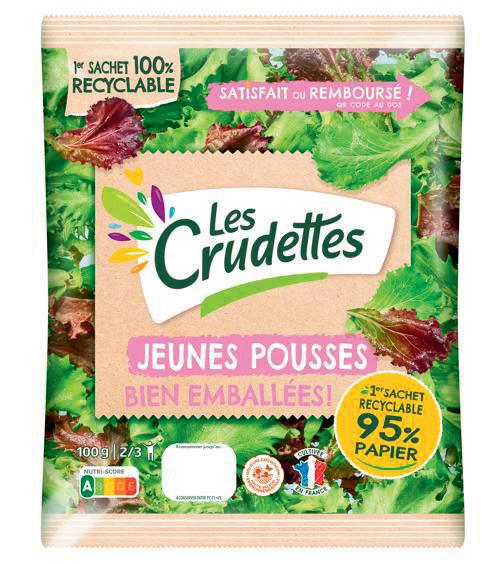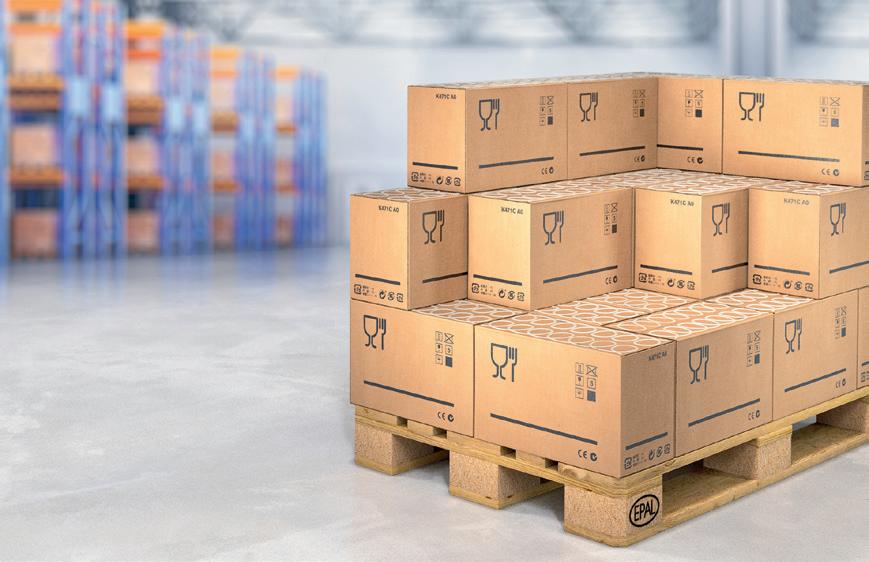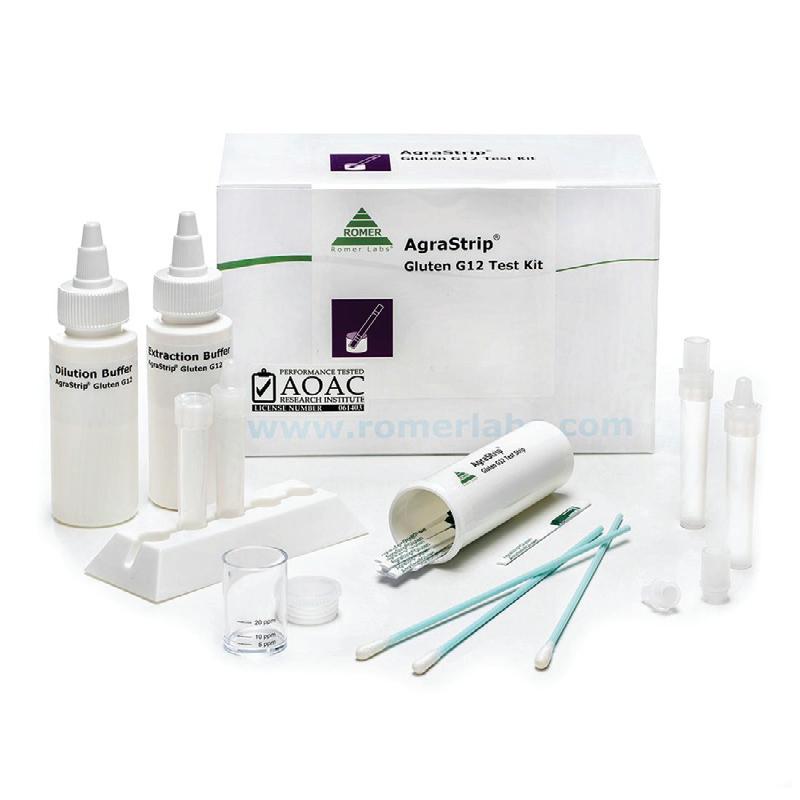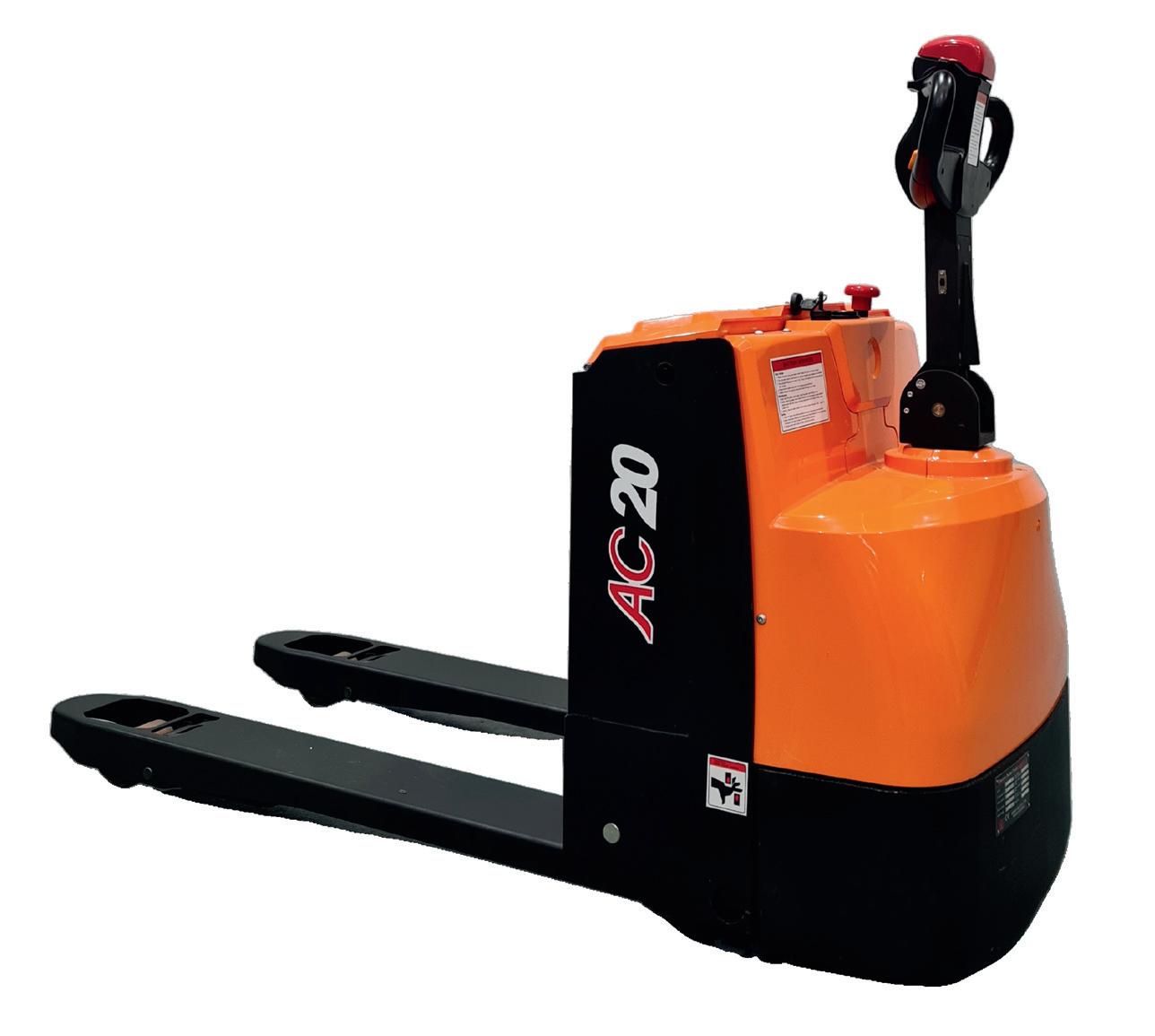
17 minute read
The labelling game challenges and trends
PACKAGING & LABELLING
The labelling game:
challenges and trends
In light of increasing regulatory demands globally, labelling today is a highly intricate process that is even more vital to products than ever before. Food and beverage industry players are particularly concerned about the costs of materials and are keen to optimise their investment while increasing brand recognition.
The following Q&A with Artem Krukov at Sidel talks about trends in labelling and how a greater focus on sustainability and flexibility is changing the way labels are created and applied.
What are the most important challenges in labelling for the beverage industry?
Similar to the manufacturing industry as a whole, beverage producers are searching for greater efficiency and lower total cost of ownership (TCO) for their labelling equipment. There is also a significant focus on sustainability. The label is one of the main interfaces for communication with the consumer. Companies are changing their labels constantly to respond to fast-changing consumer preferences.
How is labelling becoming more sustainable?
By reducing label thicknesses and surface areas, customers can cut costs and improve the carbon footprint of label production and the labelling process.
Label producers are working to ensure that labels do not affect PET recycling.
Another important trend is the conversion of labels from shrink sleeves to BOPP labels (plastic roll-fed labels for wraparound application). This is a very important step in bottle labelling, since containers labelled with shrink sleeves are difficult to recycle. Hence, the shift to BOPP labels not only provides recycling capabilities, but also helps companies reduce their carbon footprint even further.
Historically, labels have caused issues with PET recycling to food-grade standard because the label or the glue has affected the recycling process. Today there are several initiatives that can minimise this impact, namely label surface/size reduction, wash-off glue development and glue application minimisation.
What is the reason for focusing on glue characteristics?
We can observe this tendency via two trends.
First of all, customers around the world are eager to reduce the amount of glue for three reasons: 1. More glue equals higher costs. 2. Less glue usage positively impacts machine cleanliness, which leads to higher efficiency. 3. Glue affects the recycling process.
Most importantly, customers want to address all of these factors without sacrificing product quality.
The second trend can be seen only in some countries: customers want to increase glue distribution to make label application more solid and stable.
How has the move towards lighter bottles affected labelling?
Packaging design has a critical impact on the efficiency of the entire supply chain. Over the past 30 years, we have more than halved the weight of a 1.5-litre PET bottle, while increasing output

Sidel EvoDECO Multi

Sidel EvoDECO Multi label application
Laser engraved Glue Roller

speeds by 2.5 times, with considerable savings in terms of raw material and gains from a productivity perspective. Therefore, it is a story about ‘rightweighting’ — making sure that the package is minimised while still maintaining its technical performance and high consumer appeal.
Some manufacturers use nitrogen to add resistance and stability to the bottle. Sidel has designed its labellers so that they can manage the extra demands of bottle lightweighting with or even without nitrogen.
The most advanced solution for handling lightweight bottles is the Super Combi, where the labeller is placed in between the blower and the filler as part of an all-in-one solution. With this setting, labels are applied on the empty bottles handled by the neck, reducing the risk of scratches and improving overall bottle quality.
How can labelling provide more flexibility?
Labels are key components of any brand marketing mix, allowing manufacturers to differentiate their products and give end consumers the information they need and increasingly expect. The growing variety of beverage types and bottle formats has made labelling increasingly challenging. More than ever, flexibility has become a valuable benefit to beverage producers. Top priorities today are faster product and format changeovers, simple operations and optimised processes that use the same equipment for different label types, while still ensuring consistent uptime.
Product personalisation is about being able to produce smaller batches of products with their own labelling in a very short time. Hence, the main challenges are the short timeframe for creating customised graphics and labels. Personalising the label is a difficult process, as there are so many different elements involved. The change usually starts with marketing and then has to go through design and production phases and lastly storage and transport. In fact, the standard process for a label change can easily take over four months.
With the rise of online shopping, there has been a challenge to supply consistent, unique and durable packaging and label solutions. This has opened new opportunities to offer personalised packaging solutions for product protection during shipping, by rightsizing the packaging and making sure that it provides a seamless brand experience for consumers.
What is the most up-to-date Sidel labelling solution with high flexibility?
The most flexible labelling solution to date from Sidel, the EvoDECO Multi, brings next-level modularity into labelling. It offers a standardised carousel that can be equipped with up to four different labelling technologies, including hot melt, roll-fed, self-adhesive and cold glue. Moreover, switching between various labelling modules is quick and easy thanks to plug and play connections, offering producers the freedom of labelling choice and total flexibility. Meanwhile, when being part of Sidel’s Super Combi settings, the labeller can run at up to 90,000 bottles per hour (bph). Artem Krukov

NEWS
Recyclable salad bag from paper
French salad company Groupe LSDH had been looking to reduce the amount of plastic that it used packaging and to find a solution to this problem turned to Mondi. The packaging company was able to increase the salad producer’s sustainability by introducing its first paper salad bag to the Les Crudettes range. The swap to a paper bag is set to save over 130 tonnes of plastic each year.
Designed using Mondi’s EcoSolutions approach, the bag is 95% paper, which means that it is wholly recyclable. It has a special barrier layer that has been designed to keep the salads inside fresh for up to 10 days, which is exactly the same time as previous plastic bags.
The packages are flexoprinted, displaying graphics to grab the attention of potential buyers but also featuring a QR code that can be used to access relevant consumer information. They can be packaged using the existing machines already in place so that Groupe LSDH doesn’t need to make expensive and unsustainable purchases of new machinery.
“This is just the first step in the sustainability journey of our ready-to-eat salad range. The results are exciting — the packaging is created on existing machines, it looks great onshelf, is resistant to humidity and supports our sustainability goals,” said Géraldine Collet, Marketing and Innovation Director, Les Crudettes/Groupe LSDH.
Mondi Group www.mondigroup.com/en/home
Palletising adhesive packaging format
The Technomelt Supra 7220 PS Easyflow palletising adhesive packaging format from Henkel Adhesive Technologies is designed to optimise sustainability and logistics efficiency for pallet handling. Palletising is an essential part of modern supply chains, but until now it has required large quantities of plastic films, intermediate layers and anti-slip mats to stabilise and secure stacked goods. The Technomelt hot melt adhesive solution is designed to cut or fully dispense with the need for film and pallet stretch wrap. By reducing material and waste it enables manufacturers, logistics specialists, distributors and retailers to meet ever tougher sustainability goals. By using hot melt adhesives to replace large amounts of plastics, the solution can also drive safety and palletising process efficiency.
Suitable for a range of different kinds of filled goods, a hot melt adhesive joins the outer packages with each other via an automated process. This safely secures the pallets. Depending on the packaged product, the adhesives can be adapted to ensure the desired performance.
As well as reducing costs for plastic films and eliminating the use of anti-slip mats and the intermediate layers required for palletisation, the solution removes the additional costs and environmental impact of disposing of materials. Furthermore, the glued cardboard packages can themselves be recycled. For retailers, the solution provides easier and faster depalletisation, and fully automated depalletising is also made possible.
In addition to optimising logistics, the solution can help to drive new levels of safety for production line operators by eliminating manual handling of hot melt adhesive and possible exposure to high temperatures. The closed auto-feeding system, which allows for distance feeding for storage away from the production line for additional flexibility, also supports a cleaner and safer working environment. By avoiding contaminants in the system, the solution can reduce equipment maintenance demands.
Suitable for all production lines, the non-sticky mini pillows can freely flow to allow the auto-feeding system from the adhesive side. This provides a steady melt-on-demand supply into the melters without interruption or temperature fluctuations.

Sustainable label range
Avery Dennison has introduced three white, uncoated papers made from 100% recycled fibres to expand its range of sustainable label solutions for wine, spirits, food and beverages. The company has invested in recycled materials with a broad range of structure, thickness and pattern complexity to help companies find a suitable sustainable label solution. The three new white, uncoated wood-free papers are designed to have a similar look, feel and performance to conventional alternatives and all feature wet strength treatment. rNaturel Touch Craft is a thick paper with a cotton-like texture for a craft, traditional look; rNoble Blanc is a matt paper with a felt marked finish that’s excellent for high volume printing; and rSable Blanc is a smooth, matt paper that’s suitable for high-volume printing.
Combining the new recycled fibre papers with other sustainable solutions from Avery Dennison can further improve a product’s eco-credentials. Semi-gloss rMC paper is an option for back labels and is made from 100% recycled fibres. Labels that require a strong ice bucket performance can use rPLUS underlaminate, made with 70% postconsumer recyclate, to make complex construction as sustainable as possible. Liner waste can be reduced by using rPET liners, made from 30% recycled materials.
Avery Dennison
www.averydennison.com

Laser marking systems for thermoforming machines

GEA has integrated laser marking systems into its PowerPak series of thermoforming packaging machines. The marking system can be used to apply a QR code to the packaging in order to provide information to customers or to keep track of items in the production line.
The lasers can apply the codes at high speeds and in a way that results in largely indelible codes. The application process does not use ink or labels and as such the lasers can provide a sustainable method of marking products. The system is suitable for operation in dusty or moist environments.
The product can be customised to mark items before or after the thermoformer’s sealing, depending on the user’s needs. It can also be used across a range of similar but not identical products, such as items that have slightly different ingredients but the same packaging. This information is accessed from a database and can be changed without altering machinery or materials.
The product is integrated into machines on a user-specific basis.
GEA Group
www.geagroup.com.au

CASE STUDY
BevChain (a wholly owned subsidiary of Linfox) has installed a Swisslog PowerStore automated warehouse shuttle system at its facility in Auburn, NSW, to boost safety, efficiency and increase storage by around 60%.
The beverage distribution specialist delivers tailored beverage supply chain solutions across Australia and New Zealand. With 22 distribution centres across six states, it handles more than 2.5 billion serving units annually.
“PowerStore is next-generation warehouse automation. It has increased storage utilisation by around 60% in the same building footprint, created a safer workplace for our people and will deliver growth for our customers,” said Linfox President, BevChain, Misha Shliapnikoff.
The system is suitable for applications seeking to achieve high throughput and optimal space utilisation, in industries such as fast-moving consumer goods (FMCG), e-grocery and pallet warehousing. It can also operate in a range of environments, from -30°C in frozen food storage up to 50°C, and can easily be retrofitted to warehouses with low ceilings or unusual shapes.
The solution for BevChain consists of vertical conveyors that accommodate fast pallet movements between levels, RowCarriers that retrieve from, and deliver pallets to, transfer stations at the vertical conveyor, and AisleCarriers that use precision lasers to transport RowCarriers between the vertical conveyor and the designated row.
“The new 24/6 facility includes over 30,000 pallet locations, with vertical conveyors transferring pallets to and from one of five levels. It has 20 satellite AisleCarriers and RowCarriers, one in each level of the four quadrants transferring pallets to and from their location. This is all predetermined by Swisslog’s intelligent SynQ software,” Shliapnikoff said.
Swisslog’s SynQ software is fully integrated with BevChain’s warehouse management system to ensure full traceability and trackability including batch numbers and visibility on storage and throughput, using automation
for receipt despatch.
Swisslog Managing Director, Australia and New Zealand, Francis Meier said the new PowerStore system provides safety and efficiency benefits to BevChain’s operations. “Replacing manual operations with an automated system increases the accuracy of picking and removes error, which leads to fewer returns and greater profitability,” he said.
“The solution has delivered productivity benefits and makes the warehouse safer and quieter. And, because we were converting an existing manual warehouse, our team worked closely with BevChain to ensure the go-live phase was carried out in stages, to minimise the impact during commissioning,” he said.
To further enhance operational efficiency, and to ensure the system is always operating at optimal levels, BevChain partnered with Swisslog to bring on board a highly trained Swisslog system operations team to work in collaboration with BevChain onsite.
This core team works closely with BevChain to provide software support, training, condition monitoring and spare parts maintenance to improve the overall lifecycle of the automation. Swisslog Australia www.swisslog.com.au

Tote, bin and IBC filler
Flexicon’s Basic Filler for bulk boxes, totes, bins or other intermediate bulk containers (IBCs) loads bulk solid materials free of dust, at low cost. The unit’s fill head can be raised or lowered using a forklift and secured with clevis pins to minimise the clearance between the rectangular dust hood and the opening of IBCs ranging from 1220 to 1980 mm tall. A fill head port can be vented to a filter sock to contain displaced dust, or to a central bag house that causes a clear flexible skirt to vacuum-seal against the container’s exterior, increasing dust containment effectiveness. Performance can be enhanced by a vibratory deck to densify and stabilise the material during filling, and/ or load cells that signal a PLC when to stop the flow of material by stopping a conveyor or closing a rotary valve or slide gate once a programmed weight is gained.
Rated for loads up to 2945 kg, the frame is offered in carbon steel with durable industrial coating, with stainless steel material contact surfaces, or in all-stainless construction to industrial or sanitary standards.
It can be integrated with Flexicon mechanical or pneumatic conveying systems, or the user’s upstream process equipment or storage vessels.
Flexicon Corporation (Aust) Pty Ltd
www.flexicon.com.au



CASE STUDY
Automated insect protein factory to launch Q1 2022
Aspire Food Group is constructing a new facility in Canada for food-grade insect protein production using Dematic Automated Storage and Retrieval System (AS/RS) technology. The site will be used to produce crickets for processing into edible proteins, using advanced technology to facilitate the automated growing and processing of the insects.
Dematic will implement an 11-storey, high-density automated storage system using totes to breed and mature crickets prior to processing for pet and human consumption. Integrating with other technology providers, totes will be monitored to ensure food-grade quality using the Industrial Internet of Things
©stock.adobe.com/au/nicemyphoto
(IIoT) and sensors that provide data to deep-learning artificial intelligence (AI) technology to optimise conditions for maturation, breeding and incubation. The AS/RS technology will be used in a number of ways too. It will reduce the amount of human touch required in the food production process, provide oversight for accuracy across each of the system’s totes and optimise space in the site to maximise production. Other technologies will be used for the control of temperature and humidity in each tote. The site will feature a substantial number of these totes — 96,000 in all — and will produce 20,000 tonnes of cricket protein and frass (a waste that is used for fertiliser and soil supplements) each year.
The technologies being used have yet to be combined for this sort of farming before: the site will be the first time that IIoT sensors, AS/RS and AI have been used together for a climate-controlled, indoor vertical agriculture system that uses living organisms.
The project is expected to be completed in Q1 of 2022. It will be constructed in London, Ontario. Dematic Pty Ltd www.dematic.com.au
Heat pumps
The food and beverage sector requires hot air or hot water for process heating, sanitation and space heating. COP26 and increasing consumer expectations demand better stewardship of the use of fossil fuels. Decarbonisation of this heating requires that we address the challenging transition from burning gas and other forms of heating that produce high-intensity carbon emissions.
Glaciem heat pumps are distinctive because they use the refrigeration cycle with CO2 as a refrigerant. Unlike other natural refrigerants, CO2 is non-flammable and non-toxic. It has almost no global warming impact if it is released.
Glaciem heat pumps are available for large-scale heating demands up to multi-megawatt in a single system. CO2 heat pumps are also able to deliver hot water at more than 90°C or hot air at 120°C. When they are providing heating, heat pumps can also provide cooling without additional electrical power. This cooling can supplement the cooling provided by other refrigeration systems.
Heat pumps are also energy efficient, producing more thermal energy than the electrical power used to run them. When all these values are put together CO2 heat pumps can deliver economic value at scale while supporting decarbonisation in the food and beverage sector. They reduce energy consumption and maximise the use of renewable energy.
Glaciem application engineers can provide techno-economic analysis and advice to develop the feasibility analysis and to design a tailor-made heat pump around a user’s particular application and demands.
Glaciem Cooling Technologies
glaciemcooling.com

A new Flexicon Mobile Sanitary Bulk Bag Discharger with stainless steel material contact surfaces allows discharging of contamination-sensitive bulk solid materials to downstream processes, dust-free.
Mounted on castors for in-plant mobility, the BULK-OUT BFF Series discharger frame features four adjustable extension posts to accommodate bulk bags 915 to 2135 mm tall. The removable bag-lifting frame with Z-CLIP strap holders allows bulk bags to be attached at ground level, then forklifted into receiving cups atop the discharger frame.
The bulk bag/hopper interface comprises a manual SPOUT-LOCK clamp ring for high-integrity bag spout connections, and a pneumatically-actuated TELE-TUBE telescoping tube that exerts continuous downward tension on the clamp ring and bag spout as the bag empties and elongates, promoting flow and evacuation.
Additional flow is afforded by FLOW-FLEXER bag activators that raise and lower opposite bottom sides of the bag at timed intervals into a steep ‘V’ shape, promoting total discharge with no manual intervention.
The integral hopper can be equipped with a metering device for pneumatic or tubular cable conveying lines, a charging adapter for flexible screw conveyors, or a universal flanged outlet for connection to other downstream process equipment or storage vessels.
The entire unit can be rolled to various destinations throughout the plant, eliminating the cost of multiple stationary units and providing easy transport to a cleaning station between production runs.
Designed for ease of thorough cleaning, the adjustable extension posts are mounted outside of the frame posts instead of telescoping from within, while horizontal stainless steel members of round versus square tubing minimise residual water and cleaning solutions clinging to the frame following wash-down.
The system is also offered in all-stainless construction to food, dairy, pharmaceutical and industrial standards, and in carbon steel with durable industrial coatings.
Flexicon Corporation (Aust) Pty Ltd
www.flexicon.com.au


Electric Pallet Mover
• 2t,000 kg Lift Capacity • Electronic Power Steering • Regenerative Braking System • Increased Battery Life • Australian Compliant











